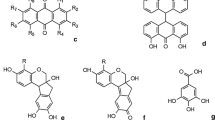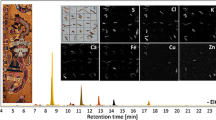Abstract
The possibility of successfully applying a common GC–MS procedure for identification in one step of all types of dyes from plants of unknown origin and from historical objects is particularly attractive due to the high separation efficiency of the capillary columns, the MS detection sensitivity and the reproducibility of results. In this work, GC–MS analysis, previously and successfully used for the characterization of anthraquinones, flavonoids and tannins from plant extracts and historical samples, has been tested on indigoid dyestuffs. An analytical procedure based on the silylating agent N,O-bis-(trimethylsilyl)trifluoroacetamide (BSTFA) with 1 % trimethylchlorosilane (TMCS) was applied to pure molecules of indigotin and indirubin and to plant extracts of Indigofera tinctoria L. and Isatis tinctoria L. Preliminary tests have been done to establish the chromatographic conditions and the derivatization amounts most suitable for the simultaneous detection of indigoid molecules and of the other natural compounds, such as fatty acids, carboxylic acids and sugars, contained within the plant extracts. In order to assess the capacity and the sensitivity of the analytical procedure in typical archaeometric applications, wool samples dyed in the laboratory with indigo were analysed by mimicking the sample amounts typically available with historical objects. The electron ionization (EI) spectra of the main silylated derivatives of indigoid molecules obtained in this way constitute the necessary data set for the characterization of natural extracts and historical works of art. Subsequently, the procedure has been applied to historical samples for the detection of indigo and of other dyestuffs eventually contained in samples. Additional information, useful for restoration and preservation of works of art, could be also obtained on the nature of stains and smudges present on the sampled textile material. The GC–MS method turns out to be an efficient and fast analytical tool also for the identification of natural indigo in plants and textile artefacts, providing results complementary to those from high-performance liquid chromatography (HPLC).







Similar content being viewed by others
References
Balfour-Paul J (1998) Indigo. British Museum Press, London. ISBN 0-7141-1776-5
Melo MJ (2009) In: Bechtold T, Mussak R (eds) Handbook of natural colorants. Wiley, Chichester, UK. ISBN 978-0-470-51199-2
Cardon D (2007) Natural dyes: sources, tradition, technology and science. Archetype, London. ISBN 190498200X
Brunello F (1968) L’Arte della tintura nella storia dell’ umanita’. Neri Pozza, Vicenza
Epstein E, Nabors MW, Stowe BB (1967) Origin of indigo of woad. Nature 216:547–549
Singer C, Williams J, Illtyd T (1954) A history of technology. Oxford University Press, London ISBN 978-0-19-858155-0; ISBN: 0-19-858155-6
Legget WF (1994) Ancient and medieval dyes. Chemical Publishing CO, Brooklyn
Wisniak J (2004) Dyes from antiquity to synthesis. Indian J Hist Sci 39:75–100
Oberthur C, Schneider B, Graf H, Hamburger M (2004) The elusive indigo precursors in woad (Isatis tinctoria L.)—identification of the major indigo precursor. Isatan A, Structure Revision B, Chem Biodivers 1:174–182
Kokubun T, Edmonds J, John P (1998) Indoxyl derivatives in woad in relation to medieval indigo production. Phytochemistry 49:79–87
Maugard T, Enaud E, Choisy P, Legoy MD (2001) Identification of an indigo precursor from leaves of Isatis tinctoria (woad). Phytochemistry 58:897–904
Seixas de Melo J, Moura AP, Melo MJ (2004) Photophysical and spectroscopic studies of indigo derivatives in their keto and leuco forms. J Phys Chem A 108:6975–6981
Seixas de Melo J, Ronda R, Burrows HD, Melo MJ, Navaratnam S, Edge R, Voss G (2006) Photophysics of an indigo derivative (keto and leuco structures) with singular properties. J Phys Chem A 110:13653–13661
Hofenk-de Graaff J H (2004) The colorful past. Origins, chemistry and identification of natural dyestuffs. Archetype Publications, London ISBN: 1873132131
Surowiec I (2008) Application of high-performance separation techniques in archaeometry. Microchim Acta 162:289–302
Wouters J (1985) High performance liquid chromatography of anthraquinones: analysis of plant and insect extracts and dyed textiles. Stud Conserv 30:119–128
Degano I, Ribechini E, Modugno F, Colombini MP (2009) Analytical methods for the characterization of organic dyes in artworks and in historical textiles. Appl Spectrosc Rev 44:363–410
Colombini MP, Modugno F (2009) Organic mass spectrometry in art and archaeology. Wiley, Chichester, UK. ISBN 0470517034
Fabbri D, Chiavari G, Ling H (2000) Analysis of anthraquinoid and indigoid dyes used in ancient artistic works by thermally assisted hydrolysis and methylation in the presence of tetramethylammonium hydroxide. J Anal Appl Pyrolysis 56:167–178
Casas-Catalan MJ, Domenech-Carbo MT (2005) Identification of natural dyes used in works of art by pyrolysis–gas chromatography/mass spectrometry combined with in situ trimethylsilylation. Anal Bioanal Chem 382:259–268
Andreotti A, Bonaduce I, Colombini MP, Ribechini E (2004) Characterisation of natural indigo and shellfish purple by mass spectrometric techniques. Rapid Commun Mass Sp 18:1213–1220
Takao Y, Yamashita K, Kohra S, Inudo M, Nagae M, Tominaga N, Ishibashi Y, Sekizawa J, Miyairi S, Arizono K (2003) High sensitivity analysis of indirubin by silylation using GC-MS. J Health Sci 49:88–90
Poulin J (2007) Identification of indigo and its degradation products on a silk textile fragment using gas chromatography-mass spectrometry. J Can Assoc Conserv (JCAC) 32:48–56
Degani L, Riedo C, Gulmini M, Chiantore O (2014) From plant extracts to historical textiles: characterization of dyestuffs by GC–MS. Chromatographia 77:1683–1696
Zanus Fortes L, Fashion and color: three eighteenth century corsets. Restoration and preventive conservation, MS Thesis in Conservation Restoration of Cultural Heritage, University of Torino, 2014
Oberthur C, Graf H, Hamburger M (2004) The content of indigo precursors in Isatis tinctoria leaves—a comparative study of selected accessions and post-harvest treatments. Phytochemistry 65:3261–3268
Mohn T, Plitzko I, Hamburger M (2009) A comprehensive metabolite profiling of Isatis tinctoria leaf extracts. Phytochemistry 70:924–934
Puchalska M, Połeć- Pawlak K, Zadrożna I, Hryszko H, Jarosz M (2004) Identification of indigoid dyes in natural organic pigments used in historical art objects by high performance liquid chromatography coupled to electrospray ionization mass spectrometry. J Mass Spectrom 39:1441–1449
Papanastasiou M, Allen NS, McMahon A, Naegel LC, Edge M, Protopappas S (2012) Analysis of indigo-type compounds in natural dyes by negative ion atmospheric pressure photoionization mass spectrometry. Dyes Pigments 92:1192–1198
Acknowledgments
CRITT Horticole (Rochefort sur Mer, France) is gratefully acknowledged for supplying the plant extracts. This work has been partially supported through the PRIN 2010-2011 (MIUR, Italy) project: Sustainability in cultural heritage: from diagnosis to the development of innovative systems for consolidation, cleaning and protection.
Author information
Authors and Affiliations
Corresponding author
Rights and permissions
About this article
Cite this article
Degani, L., Riedo, C. & Chiantore, O. Identification of natural indigo in historical textiles by GC–MS. Anal Bioanal Chem 407, 1695–1704 (2015). https://doi.org/10.1007/s00216-014-8423-2
Received:
Revised:
Accepted:
Published:
Issue Date:
DOI: https://doi.org/10.1007/s00216-014-8423-2




